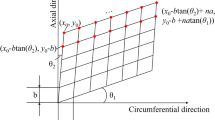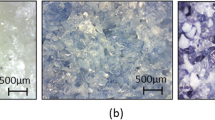Abstract
The single-layer superabrasive wheels are made by joining all abrasive grains onto the wheel hub through electroplating or brazing processes. Recently, the attention has risen to acquire a better grinding quality through more stringent grain size control. It is found that any small deviation in the grain dimensional distribution will result in considerable difference in the grinding quality. Therefore, the understanding on correlation between the grain dimensional deviations with the wheel performances will be critical, and the primary step is to establish the correlation between the critical wheel design parameters with the wheel topographical features. In this paper, the ‘through-the-process’ grinding wheel model is developed for single-layer electroplated cubic boron nitride (CBN) wheels by simulating each wheel fabrication procedure, numerically. The efficacy of the wheel model is verified by comparing simulation results with the experimental measurement data in terms of the static grain count and grain protrusion height distribution, and further analysis of the intrinsic relationship between the grain dimensional distribution and the wheel surface topographical properties is carried out so as to provide the quantitative basis for grinding wheel quality control and optimal abrasive product design.
Similar content being viewed by others
References
Johnson GA (1987) CBN wheel grinding. J Met Forum Features 9:62–63
Chen X, Rowe WB, Cai R (2002) Precision grinding using CBN wheels. Int J Mach Tools Manuf 42:585–593
Insaki I, Tösnhoff HK, Howes TD (1993) Abrasive machining in the future. Ann CIRP 42(2):723–732
Jackson MJ, Davis CJ, Hitchiner MP, Mills B (2001) High-speed grinding with CBN grinding wheels—applications and future technology. J Mater Process Technol 110:78–88
Tönshoff HK, Peters J, Imsaki I, Paul T (1992) Modelling and simulation of grinding processes. Ann CIRP 41:677–688
Aurich JC, Braun O, Wamecke G (2003) Development of a superabrasive grinding wheel with defined grain structure using kinematic simulation. Ann CIRP 52:275–280
Warnecke G, Zitt U (1998) Kinematic simulation for analyzing and predicting high-performance grinding processes. Ann CIRP 47(1):265–270
Aurich JC, Braun O, Warnecke G (2003) Development of a superabrasive grinding wheel with defined grain structure using kinematic simulation. CIRP Ann Manuf Technol 52(1):275–280
Inasaki I (1996) Grinding process simulation based on the wheel topography measurement. Ann CIRP 45(1):347–350
Zhang X, Xu H, Fu Y (2006) Measurement technique of grinding wheel topography based on binocular stereo vision. Mater Sci Forum 532–533:1132–1135
Blunt L, Ebdon S (1996) The application of three-dimensional surface measurement techniques to characterizing grinding wheel topography. Int J Mach Tools Manuf 36(11):1207–1226
Butler DL, Blunt LA, See BK, Webster JA, Stout KJ (2002) The characterization of grinding wheels using 3D surface measurement techniques. J Mater Process Technol 127:234–237
Furutani K, Ohguro N, Hiequ NT, Nakamura T (2002) In-process measurement of topography change of grinding wheel by using hydrodynamic pressure. Int J Mach Tools Manuf 42:1447–1453
MAV: Fertigung (2012) Oberflächen-Analyse. http://www.mav-online.de/fertigung/-/article/46701/26916644/Oberfl%C3%A4chen-Analyse/art_co_INSTANCE_0000/maximized/. Accessed 12 Jul 2012
Zeiss (2012) EVO MA. http://microscopy.zeiss.com/microscopy/en_de/products/scanning-electron-microscopes/evo-materials.html. Accessed 12 Jul 2012
Doman DA, Warkentin A, Bauer R (2006) A survey of recent grinding wheel topography models. Int J Mach Tools Manuf 46:343–352
Zhang Z, Zhang X, Xu C, Guo D (2013) Characterization of nanoscale chips and a novel model for face nanogrinding on soft-brittle HgCdTe films. Tribol Lett 49:203–215
Zhang Z, Song Y, Xu C, Guo D (2012) A novel model for undeformed nanometer chips of soft-brittle HgCdTe films induced by ultrafine diamond grits. Scripta Mater 67:197–200
Chen X, Rowe WB (1996) Analysis and simulation of the grinding process: part I: generation of the grinding wheel surface. Int J Mach Tools Manuf 38(8):871–882
Koshy P, Jain VK, Lal GK (1997) Stochastic simulation approach to modelling diamond wheel topography. Int J Mach Tool Manuf 37(6):751–761
Koshy P, Jain VK, Lal GK (1993) A model for the topography of diamond grinding wheels. Wear 169(2):237–242
Torrance AA, Badger JA (2000) The relation between the traverse dressing of vitrified grinding wheels and their performance. Int J Mach Tool Manuf 40(12):1787–1811
Hegeman JBJ-W (2000) Fundamentals of grinding—surface conditions of ground materials. University of Groningen, Netherlands
Wang Y, Moon KS (1997) A methodology for the multi-resolution simulation of grinding wheel surface. Wear 211:218–225
Balasz B, Szatkiewicz T, Krolikowski T (2007) Grinding wheel topography modeling with application of an elastic neural network. Advanced intelligent computing theories and applications. With aspects of artificial intelligence. Lect Notes Comput Sci 4682:83–90
Aurich JC, Herzenstiel P, Sudermann H, Magg T (2008) High-performance dry grinding using a grinding wheel with a defined grain pattern. CIRP Ann Manuf Technol 57:357–362
Chakrabarti S, Paul S (2008) Numerical modelling of surface topography in superabrasive grinding. Int J Adv Manuf Technol 39:29–38
Rao RV (2011) Advanced modeling and optimization of manufacturing processes. Springer, London
Li X, Lu Y, Li Q, Li F, Rong YK (2013) The study on the influences of superabrasive grain spatial orientation for microcutting processes based on response surface methodology. Int J Adv Manuf Technol 67(5–8):1527–1536
Stephens MA (1974) EDF statistics for goodness of fit and some comparisons. J Am Stat Assoc 69:730–737
Author information
Authors and Affiliations
Corresponding author
Rights and permissions
About this article
Cite this article
Li, X., Wolf, S., Zhi, G. et al. The modelling and experimental verification of the grinding wheel topographical properties based on the ‘through-the-process’ method. Int J Adv Manuf Technol 70, 649–659 (2014). https://doi.org/10.1007/s00170-013-5301-6
Received:
Accepted:
Published:
Issue Date:
DOI: https://doi.org/10.1007/s00170-013-5301-6




